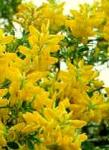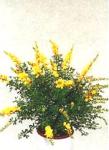|
|
CytisusFamily: Fabaceae.
|
Common name(s): Broom, Genista |
Cytisus X racemosus Nichols. |
 |
Syn. Argyrocytisus.
Genus of about 50 species of deciduous to evergreen shrubs, small trees, from Europe, W. Asia, N. Africa, found in well-drained soils, usually in open sites, from high mountains to scrub and heathland at lower altitudes. Cytisus is a very attractive form of Broom with scented yellow flowering spikes. It is best kept as a houseplant when in flower and then put out into the garden to spend the summer months there.
Indoors keep it cool, minimum of 40'F and well watered. They have a tendency to drop their leaves due to a lack of humidity indoors. Prevent this by standing the pot on a tray of damp pebbles and misting regularly. Place your plant in a well lit spot indoors and repot after it has finished flowering ready for its 'summer holiday' in the garden. The dead flower shoots should be cut off at this time.
Cytisus outdoors is called Broom - indoors it is Genista. Yellow flowers appear in spring.
All parts, especially the seeds, may cause mild stomach upset if ingested. |
 |
| Growing conditions |
Watering and misting |
Propagation |
| Keep the plant warm - minimum 50F in winter. Some direct sun is essential. Grow in soil-based potting mix in full light. |
Water moderately from spring to autumn. Water sparingly in winter. Misting is necessary. You can use hard water for watering! |
Take ripewood stem cuttings in spring or midsummer, and semi-rioe cuttings in late summer. Use a rooting hormone and provide bottom heat. Sow seed in a cold frame in autumn and spring. |
|
These materials are freely provided for instructional and educational purposes. Any duplication or publication of text or images herein for commercial gain without explicit written permission of the owner or photographer constitutes breach of trust and violation of copyright.
Copyright © Galka Okhapkina 1998-2025


